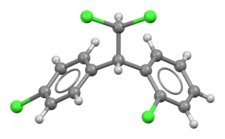 | |
 | |
| Clinical data | |
|---|---|
| Trade names | Lysodren |
| Other names | 1,1-(Dichlorodiphenyl)-2,2-dichloroethane; o,p'-DDD |
| AHFS/Drugs.com | Monograph |
| MedlinePlus | a608050 |
| License data | |
| Routes of administration | By mouth |
| ATC code | |
| Legal status | |
| Legal status | |
| Pharmacokinetic data | |
| Bioavailability | 40% |
| Protein binding | 6% |
| Elimination half-life | 18–159 days |
| Identifiers | |
| |
| CAS Number | |
| PubChem CID | |
| IUPHAR/BPS | |
| DrugBank | |
| ChemSpider | |
| UNII | |
| KEGG | |
| ChEMBL | |
| CompTox Dashboard (EPA) | |
| ECHA InfoCard | 100.000.152 |
| Chemical and physical data | |
| Formula | C14H10Cl4 |
| Molar mass | 320.03 g·mol−1 |
| 3D model (JSmol) | |
| Chirality | Racemic mixture |
| Melting point | 76 to 78 °C (169 to 172 °F) |
| |
| |
| (verify) | |
Mitotane, sold under the brand name Lysodren, is a steroidogenesis inhibitor and cytostatic antineoplastic medication which is used in the treatment of adrenocortical carcinoma and Cushing's syndrome.[4][5][6][7] It is a derivative of the early insecticide DDT and an isomer of p,p'-DDD (4,4'-dichlorodiphenyldichloroethane) and is also known as 2,4'-(dichlorodiphenyl)-2,2-dichloroethane (o,p'-DDD).[8]
- ^ "FDA-sourced list of all drugs with black box warnings (Use Download Full Results and View Query links.)". nctr-crs.fda.gov. FDA. Retrieved 22 October 2023.
- ^ "Product monograph brand safety updates". Health Canada. 7 July 2016. Retrieved 3 April 2024.
- ^ "Lysodren EPAR". European Medicines Agency. 12 June 2002. Retrieved 27 June 2024.
- ^ Cavagnini F, Giraldi FP (18 May 2010). "Adrenal Causes of Hypercortisolism". In Jameson JL, De Groot LJ (eds.). Endocrinology - E-Book: Adult and Pediatric. Elsevier Health Sciences. pp. 1888–. ISBN 978-1-4557-1126-0.
- ^ Hahner S, Fassnacht M (April 2005). "Mitotane for adrenocortical carcinoma treatment". Current Opinion in Investigational Drugs. 6 (4): 386–394. PMID 15898346.
- ^ Dang C, Trainer PJ (1 October 2010). "Medical Management of Cushing's Syndrome". In Bronstein MD (ed.). Cushing's Syndrome: Pathophysiology, Diagnosis and Treatment. Springer Science & Business Media. pp. 156–. ISBN 978-1-60327-449-4.
- ^ Elks J (14 November 2014). The Dictionary of Drugs: Chemical Data: Chemical Data, Structures and Bibliographies. Springer. pp. 382–. ISBN 978-1-4757-2085-3.
- ^ "Mitotane". PubChem. U.S. National Library of Medicine.